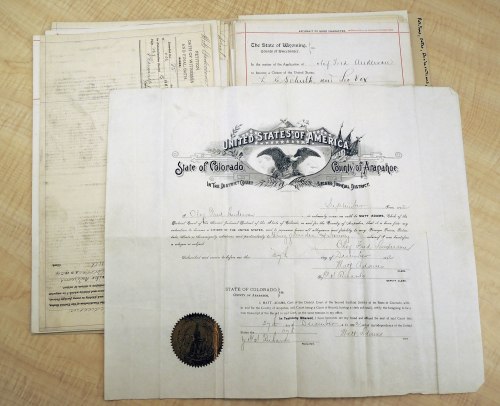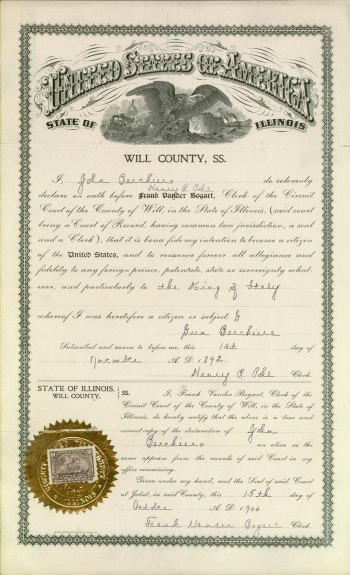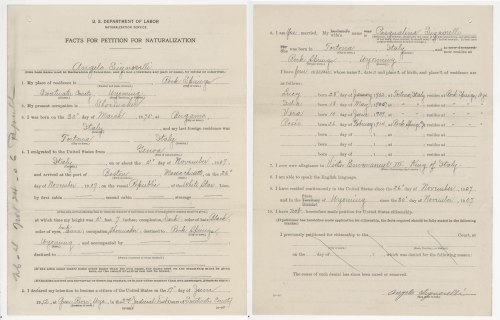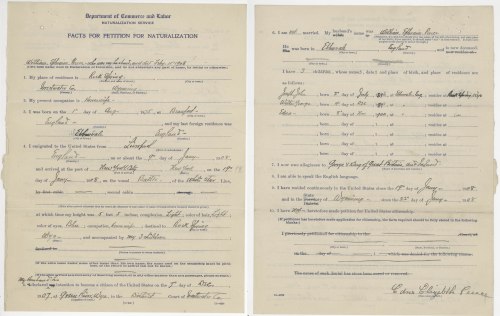Sweetwater County boasts an amazing variety of ethnicities, thanks in large part to the abundance of coal mines in the area. Starting in 1867, with the arrival of the Union Pacific Railroad tracks, young men from all over Europe and Asia flooded into the area seeking quick cash in the mines. They came from Austria, Sweden, Finland, Italy, Great Britain, China, Hungary, France, and elsewhere. Some of these young men saw potential in these mining communities and decided to stay and build their lives in the area. For many, this included gaining citizenship.

Certificate of Citizenship issued in Sweetwater County to Romedio Anselmi, 1900.
(WSA, Sweetwater County District Court Naturalization Records)
During the heyday of immigration to Sweetwater County, the naturalization process was organized by the Department of Labor but actually carried out by the counties, which means that many of the naturalization records are filed at the county level rather than the national level. In Sweetwater County, this meant that the district court retained the letters of intent, petitions and citizenship oaths between approximately 1900 and 1930. These records were eventually transferred to the Wyoming State Archives for permanent storage.
The process to gain citizenship was simple, if lengthy. The first step was to file a Declaration of Intent, which many immigrants filed almost immediately upon stepping foot in America. After 5 years of continued residency, they could apply to their county of residence for naturalization. As proof, they were required to produce 2 character witnesses, each of whom was interviewed and their answers documented on a form. Once all of the information and documentation was verified, they could be granted citizenship, renouncing all allegiance to their former homes and gaining all of the rights and privileges of a US citizen.

Some of the Declaration of Intention certificates include beautiful artwork. This one is from Arapahoe County, Colorado.
(WSA Sweetwater County District Court Naturalization Records)

An example of a Declaration of Intention certificate from Will County, Illinois.
(WSA Sweetwater County District Court Naturalization Records)
The naturalization files provide a fascinating peek into the lives of those immigrants who were applying for citizenship. The records show immigrants from Austria, Finland, Sweden, England, Scotland, Ireland, Wales, Greece, Russia, Germany, Italy, Hungary, Denmark, Norway, France and Spain. Most of these men were miners or railroad workers, but others worked as barkeeps, shoemakers, hotel owners, and even a Catholic priest. The Fact for Petition of Naturalization forms provide wonderful biographical information, including when and where they were born, where and how they arrived in the country, their present occupation, family members, and if they were sponsored by anyone.

The Facts for Petition of Naturalization form for Angelo Signorelli states that he was Italian and worked as a shoemaker in Rock Springs. He arrived by himself, but at some point must have sent for his wife and children as they are shown living in Rock Springs as well.
(WSA Sweetwater County District Court Naturalization Records)
Citizenship was a family affair. A man’s wife and minor children were also granted citizenship under his name. Matters could be complicated if the husband died after he filed his declaration but before he was granted citizenship. Once the requisite time had past, the widow would file her forms under her husbands’ name rather than her own. Their minor children would still be granted citizenship under their parents.

According to her Facts for Application for Naturalization form, Mrs William Preece was widowed before her husband was granted citizenship, which meant that she had to apply under her husbands name in order for the names on the paperwork to match.
(WSA Sweetwater County District Court Naturalization Records)
While minors (those under 21 years of age) could not become citizens on their own, they could file a declaration of intent at age 18 and for citizenship at age 21, if they met the 5 year residency requirement.
Every once in a while, new citizenship would be revoked, sometimes even after the person’s Certificate of Citizenship had been issued. According to the paperwork filed in Sweetwater County, in most, if not all, of these instances in the county were because the applicant had not met the necessary residency requirement.

This letter gives the specific reasons Giovanni Corrazo’s naturalization was revoked.
(WSA Sweetwater County District Court Naturalization Records)

Cancelled citizen certificates. In both of these cases, citizenship was revoked because officials found out that the applicant had not lived in the US long enough to qualify for citizenship.
(WSA Sweetwater County District Court Naturalization Records)
The men who arrived at the mines were often sponsored by representatives of the mine. The sponsors would meet and escort the new recruits to Sweetwater County, help them find lodging and report for work. They often also acted as witnesses when the men applied for citizenship.

The same two men stood up as witnesses for nearly all of the applicants of this page. These two were probably employees at the mine. Since they would have seen the applicants at work on a regular basis, they were qualified to say whether the men had indeed met the residency requirement.
(WSA Sweetwater County District Court Naturalization Records)











